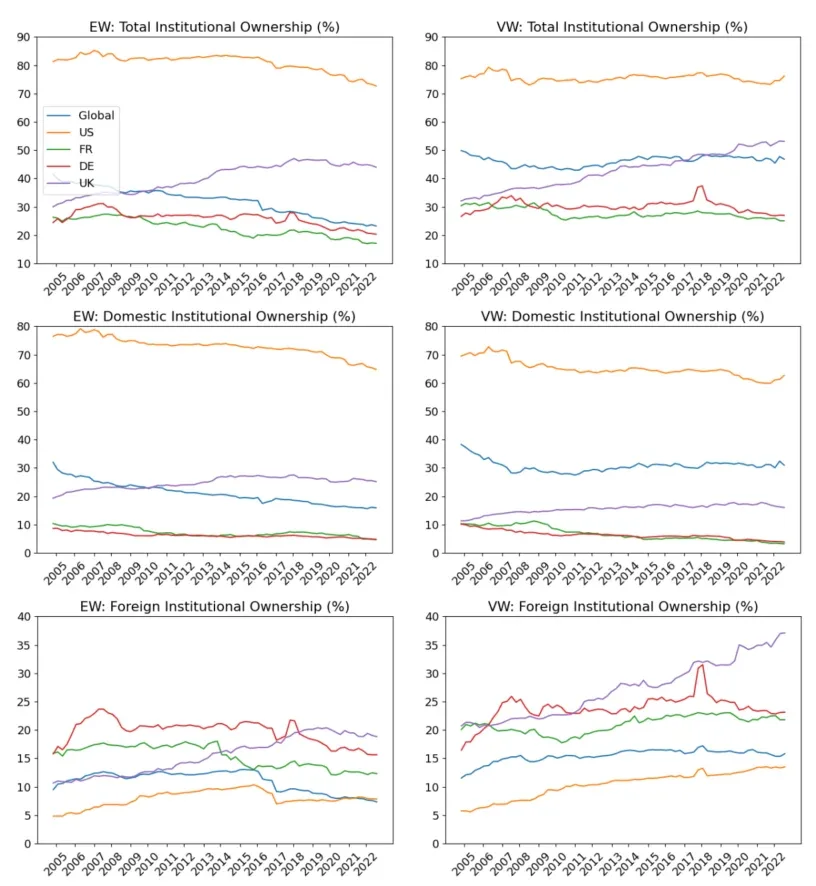
HKU Jockey Club Enterprise Sustainability Global Research Institute
World-Class Hub for Sustainability
Patrick Bolton|Marc Eskildsen|Marcin Kacperczyk
Carbon Home Bias
Mar 24. 2025
Key Takeaways
- The paper explores how institutional investors treat companies with high carbon emissions, highlighting the underrepresentation of such firms in institutional portfolios, particularly when they are foreign.
- A significant “carbon home bias” is revealed, where domestic high-emission firms tend to be favored in portfolios, while foreign high-emission firms are often excluded.
- Political dynamics, institutional size, and the host country’s environmental policies play a crucial role in shaping these investment decisions.
- The study uncovers the influence of political events (e.g., shifts in US climate policy) and national environmental performance on investment strategies, suggesting institutional investors’ decisions are far from purely driven by financial considerations.
Source Publication:
Bolton, P., Eskildsen, M., & Kacperczyk, M. (2025). Carbon Home Bias. SSRN Working Paper.
Background and Research Questions
With the increasing urgency to address climate change, institutional investors have become key players in shaping the financial world’s response to carbon risks. These investors hold significant power to drive the decarbonization agenda by adjusting their portfolios based on companies’ carbon footprints. But how do institutional investors decide where to place their capital in a world moving rapidly toward sustainability?
This paper seeks to uncover the underlying dynamics that influence institutional investors’ decisions regarding firms with high carbon emissions. Whereas traditional models might suggest investors should prioritize efficient diversification and carbon-risk hedging, this research explores whether other factors—such as behavioral biases, political ties, and regional climate policies—steer investment decisions away from the most efficient paths.
Data and Methodology
Spanning 2005–2022, the study draws from a rich dataset that tracks institutional ownership and carbon emissions across different sectors and geographies. By examining both the intensive margin (how much investors allocate to each firm) and the extensive margin (whether they even hold positions in carbon-intensive firms), the paper investigates how different forms of institutional ownership—domestic versus foreign—influence the treatment of carbon emissions in portfolios.
The analysis incorporates firm-level data such as the book-to-market ratio, leverage, and return on equity, as well as institutional-level variables including portfolio share, institutional size, and the Climate Change Performance Index (CCPI) of the institution’s home country. These variables help paint a comprehensive picture of how both financial and non-financial factors shape investment decisions.
Findings and Discussion
The findings are striking. A distinct pattern in institutional investment behavior emerges: a carbon home bias. Essentially, institutions are more likely to favor domestic firms with high carbon emissions, whereas foreign firms exhibiting the same environmental impact are significantly underweighted in portfolios. This trend suggests that beyond the economic and environmental risks, institutions might be factoring in a deeper layer of political, social, and business considerations—such as a country’s climate stance or the institution’s connections to local industries.
Figure 1: Institutional Ownership over Time: Total, Domestic, and Foreign Breakdown for the Sample Firms on an Equal- and Value-Weighted Basis

Note: Figures show institutional ownership over time for the sample firms globally (“Global”), in the US, France (“FR”), Germany (“DE”), and the UK. The sample period is 2005–2022. The left-hand-side panel shows equal-weighted ownership, and the right-hand side shows value-weighted ownership. The top, middle, and bottom rows show total, domestic, and foreign ownership, respectively.
Further examination reveals the size of the institution plays a critical role. Larger institutions, namely, those with more substantial assets under management, tend to exhibit a stronger preference for domestic high-emission firms. The reason may be that their larger portfolios are more aligned with national industries, or they may have greater leverage to push back against global climate norms.
A particularly intriguing aspect of the study is the influence of national climate policy. Institutions based in countries with stronger environmental policies, as indicated by the CCPI, are more likely to align their portfolios with global decarbonization goals. Conversely, in countries with less stringent climate regulations, institutions often show a preference for keeping domestic carbon-intensive companies in their portfolios.
Additionally, the study highlights the significant role of political shifts—specifically, changes in US climate policy under the Trump and Biden administrations. The analysis shows political changes can dramatically affect institutional investment behavior, with foreign ownership and climate-emission strategies often shifting in response to these national policy changes.
Policy or Market Implications
The research holds important lessons for institutional investors, policymakers, and corporate leaders alike. The findings suggest that although institutional investors may claim to prioritize carbon-risk mitigation and portfolio diversification, their decisions are still influenced by a mix of behavioral biases, political considerations, and national interests. This “carbon home bias” reflects the complexity of climate-conscious investing, where factors such as local business ties, political polarization, and national policies can influence how carbon emissions are weighted in investment decisions.
For policymakers, the results emphasize the importance of shaping national environmental policies that not only push for emissions reductions but also guide institutional investors toward more sustainable, global portfolios. The study also suggests climate-conscious investors need to look beyond the financials of firms and consider the broader political and environmental context that may influence corporate sustainability strategies.
Ultimately, the paper highlights that to truly decarbonize global portfolios, investors must overcome these biases—both political and geographic—and adopt a more holistic, global approach to sustainability.